|
Memories of the old Emmitsburg High School
Mary Catherine Shields
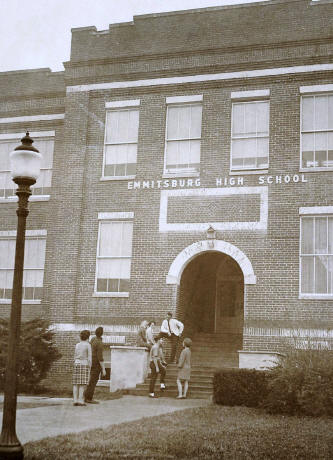 Welcome to the world of the Emmitsburg High School on South Seton Avenue which was built in 1922 and is now known as the Emmitsburg Community Center. The three-story building once housed first through 11th grades. The basement consisted of the cafeteria, where
dishes were washed by hand and upper grade students helped serve meals and did clean up each day in exchange for a free lunch; a music room; the furnace room, which had a coal bin, steam-producing furnace and the janitor's quarters occupied by 'Pappy' Kugler, who cleaned the whole school by himself; the Industrial Arts room, which was a shop where only the men could learn
about woodworking, etc.; and a room that served as the biology/lab and physics area. Welcome to the world of the Emmitsburg High School on South Seton Avenue which was built in 1922 and is now known as the Emmitsburg Community Center. The three-story building once housed first through 11th grades. The basement consisted of the cafeteria, where
dishes were washed by hand and upper grade students helped serve meals and did clean up each day in exchange for a free lunch; a music room; the furnace room, which had a coal bin, steam-producing furnace and the janitor's quarters occupied by 'Pappy' Kugler, who cleaned the whole school by himself; the Industrial Arts room, which was a shop where only the men could learn
about woodworking, etc.; and a room that served as the biology/lab and physics area.
There was one bathroom for the boys and one for the girls and two storage areas. On the first floor, where the main entrances were located, a library was to the left of the front door and the principal's office and storage area for the teachers' supplies were to the right. There were classrooms for first, second, third, fourth
and sixth grades with stairwells at either end. On the second floor (the top) was the fifth grade, the algebra/math, Latin/English, and History classrooms plus the gym/ auditorium and the Home Economics room with two storage rooms (one Storage room served as a Sick Room sometimes).
My class (1954) embarked on our educational journey in 1942 with Ms. Sarah White Kerr as our first teacher and protector from all those BIG kids. We arrived at school on one of the many buses or walked the streets and alleys through Emmitsburg to our daily destination in the rain, snow, sleet, wind and boiling hot sun. There
were no parents driving the children to school. The children who lived on Waynesboro Road had no bus service and therefore walked the greatest distance to school.
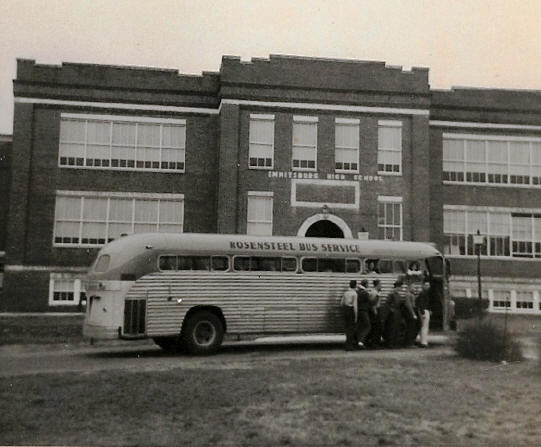
Bus service in that area began in the late 1940's or 1950. We heard bells ringing during the day which told the high school students when to change class. The only bell we listened for was the little hand bell that rang to end recess period. We learned about fire drills, which required us to leave our room and move quickly
outside. There were also lessons on what to do during an air raid, in which we had to crawl under desks or tables and wait for an all-clear signal to return to normal duties of the day (remember this was during World War II).
We survived the first year of tears, skinned knees and playground scuffles to move on to Ms. Sarah Edwards' second grade (Ms. Edwards was Dr. Cadle's sister-in-law). By second grade, we could count and became aware that we boarded the buses at 3:30 pm by the number of bell rings for each bus (each bus lined the driveway in front
of the school and was assigned a number).
Next, we encountered the domain of Ms. Edna Stull's third grade (by the way her room was the closest room to the Principal's office). Ms. Stull laid down the law the first day you entered her room: no talking unless she called on you; no chewing gum or cough drops; go to the bathroom during recess break or lunch period; and do
not leave your seat until you have permission.
Like many classes before us, and without too many mental impairments, we made it to Mrs. Helen Walters' fourth grade. Mrs. Walters was the motherly type and a very capable teacher who made learning an entertaining experience. We moved on to Ms. Helen Martin's fifth grade (a familiar face to us since Ms. Martin graduated the year
we started school and some of us rode the bus with her in 1942). The boys were very well-behaved in her class since she was the prettiest and youngest teacher to-date in their school years and they did not want to make a bad impression.
One of our favorite past times when the weather was bad and we could not go outside for recess was to walk the main hallway and try to identify all the past graduates that we knew or were our relatives. It was a custom of EHS to hang the class picture of each graduating class in the main hallway, which became quite a gallery
dating from 1922.
Then came sixth grade with Mrs. Mary Smith Scott, another graduate of EHS. Mrs. Scott was a talented teacher who played the piano, sang and knew when to be serious and when to be jovial. She had a full classroom that year since she had the full sixth grade and part of another class; the classes had to be divided due to the large
number of students enrolled in the late l940s.
At recess time in the spring, Mrs. Scott would give us paper grocery bags (in those days, you got paper bags at the store, no plastic) and we would go out on the lawn and pick dandelion blossoms. The blossoms were used to make wine. (There were no chemicals used on the lawns during those days.) A real treat for our class in both
the first and sixth grades was that the classroom windows faced South Seton Avenue, looking out to the railroad station and Lester Fox’s gas station. Mr. Guy Baker, Sr. was freight master.
As we grew older, approaching our teen years, we moved to seventh grade with Mrs. Mary Higbee Hoke as our homeroom teacher. Mrs. Hoke was a graduate of EHS and married Harold Hoke, also a graduate of EHS and owner of the local hardware store on Main Street.
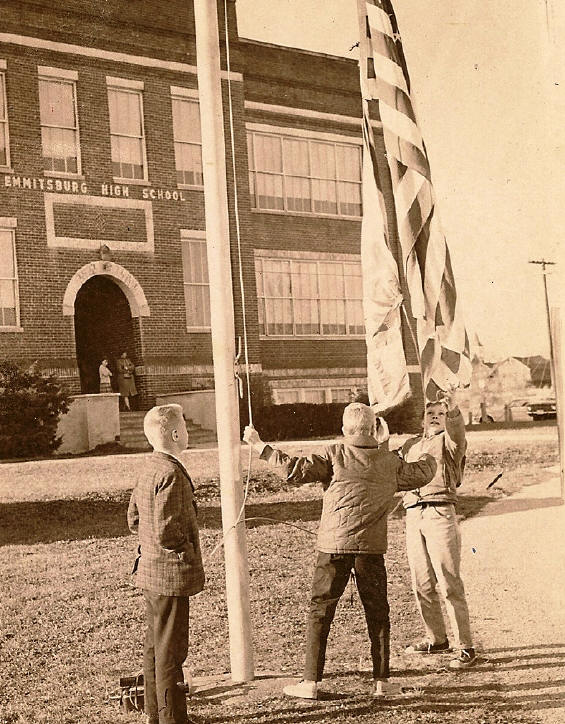
This was the first year that we changed classrooms for various subjects, which meant those ringing bells become a major item in our daily lives and not just a signal to board the bus for home. Mrs. Hoke taught Algebra and was the girls' coach for sports. Seventh grade was our first year for Latin with Mrs. Hazel Kellogg
Caldwell; Industrial Arts [Shop] for the boys; Home Economics for the girls; tryouts for all school plays and sports teams; Glee Club; Safety Patrol; Future Farmers of America (FFA); Future Teachers of America (FTA); Student Council; Senior Orchestra; a position with the high school paper staff (EHS Times), among other activities in our school career.
Also, this year, we learned what it was to hustle from the basement floor to the top floor in five minutes for class and then, in fifty minutes, go down three flights of stairs to the basement for the next class. We never did figure how many trips we made on those stairs. Many changes came with seventh grade: changing classes in
five minutes, no recess, bathroom stops were premium since there was only one bathroom for each gender located on the basement floor. wow!
By this time it is 1949 for our class; the year the high school realm faced a big change. The school grades were first through 11, but the Board of Education and the State of Maryland decided another grade should be added to make the school period first through 12 years to earn a diploma. Emmitsburg High School awarded three
types of diplomas – academic, agricultural and general (not much variety at that time). Needless to say, there was no graduating class in 1949. That class completed another year of study and graduated in 1950.
We moved on to eighth grade or freshman year of high school. Mrs. Alma Jones was our homeroom teacher and taught us American History. We had many more activities to participate in, such as basketball, soccer, baseball, volleyball, track and field events; all-county chorus; sock-hops; Halloween, Christmas, and Spring dances;
maybe even an invitation to the school prom by an upper class member.
The first of May was a very special day of activities for the entire school to participate in. There was the crowning of the May Queen and her court (all senior girls) usually escorted by the FFA boys; the May Pole with all elementary classes dancing around the pole.
Then the Home Economics’ girls put on a fashion show wearing their creations sewn over the year. The shop boys displayed of their woodworking projects and the FFA had their project display as well. The school orchestra and Glee Club performed. Our parents and families were the guests of the day. Tea was usually served to the mothers.
We survived freshman year and during the moving-up assembly in June we moved to sophomore seats and pushed forward to the second year of high school. Our homeroom was now in the cafeteria with Mr. William Baker (Agriculture teacher) as our guiding light in 1951. Rumors were flying about that an addition was in the process for
our school.
The addition would consist of an auditorium-gymnasium, one classroom, a kitchen and cafeteria, showers and dressing rooms for each gender, and storage rooms for the sum of $185.740. The contractor was Allen Feeser of Taneytown, MD. This addition was added to the south end of the existing building. As we look back over the years,
there was an oversight during the construction - the original 1922 cornerstone of the high school was not removed and was covered by the new construction. We lost some history by that action. Of course, we went about our studies and activities throughout the year but made daily checks on the progress of the new addition, plus we were fighting the dust and noise.
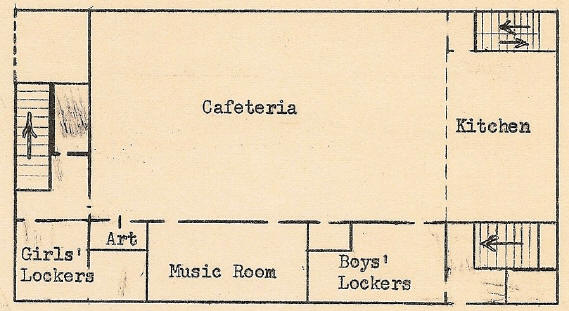
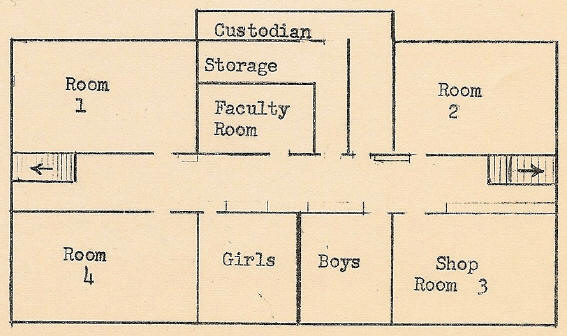
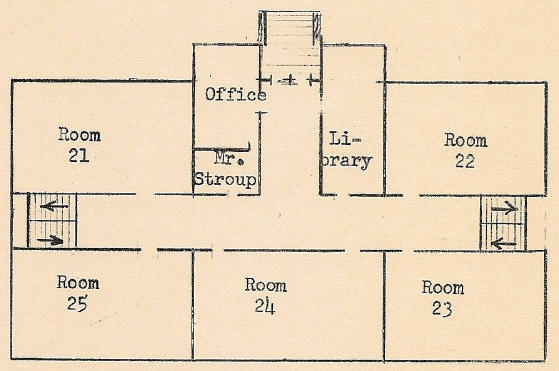
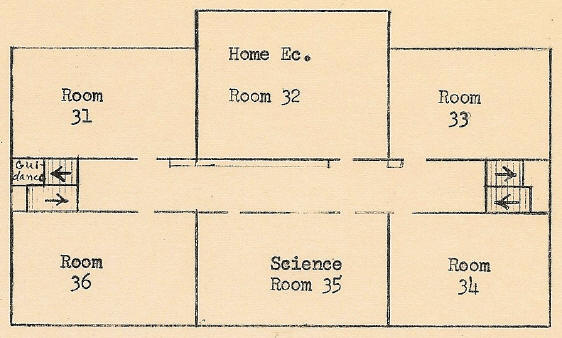
The building was finished for the 1952 graduating class and for our moving up to fill the junior year seats. Mr. Carlos Englar, the boys coach and biology/physics teacher was our homeroom advisor. The subjects became more difficult, but we managed to balance our studies, extracurricular activities and after-school jobs. This was
a super special year for us because we got our class rings. Our class rings were a set design used for many years – yellow gold with black onyx and an insignia representing the wings of knowledge. There was no choice available but the standard as shown by the Balfour Company. The basic ring was about $15.00. You could add your initials or name inside the ring for an
additional charge - some of our rings cost $18.00 plus change depending on the length of your name. Some of our class received their rings as Christmas gifts that year.
Speaking of Christmas, it was a custom of the high school to place a large tree in the main hallway facing the front entrance. It was the responsibility of the juniors and seniors to get the tree and decorate and care for the tree during the holiday season. Every morning a different class would gather around the tree and sing
one or two carols, which was the beginning of the day's activities. The tree had to be dismantled the day before holiday vacation. When we returned to school after holiday vacation, there was one big event on our minds: the Junior-Senior Prom.
Proms were held in the gym and expenses were shared by the two classes. So much planning was involved – get an orchestra (yes, we had live music - no records or DJ), select a theme for the affair, get chaperones, refreshments, have programs printed, decorate, and most important Éget a gown, order a tux and remember the flowers
(what color, wristlet or pin-on type). The big night arrived - there were no limos. Everyone double-dated so you had a ride (sometimes it was a pick-up truck with four occupants), but a great time was had by all. After the prom, everyone loaded in the available vehicles and headed to Rouzerville to the Big Dipper or maybe the Varsity field (the two best known teen hangouts
in the area).
Finally June 1953 arrived and the class of 1954 moved to the senior Seats. Mr. Eugene Woods, shop teacher, was our homeroom teacher. This year we saw several students get full-time jobs and quit school and move to the outside world. There were only twelve students remaining from the starting class of 1942, but fortune smiled on
us with Wilhelm May, a German exchange student joining our family, making us 13, a bakers' dozen. We were busy studying, trying to keep the grades high, applying for scholarships and trying to decide where to go after graduation.
Our activities were much like our junior year – sports, extracurricular activities, such as Glee Club, orchestra, FTA, FFA, patrol, duties of publishing the senior edition of the E-HI Times. Some of the class members mastered the Maryland drivers test and were trying to get their parents to ease their hold on the family car
keys. Finally, June 1954 came around, the entrance march began (Pomp and Circumstance) and seven girls in white gowns and six boys in blue gowns entered the gym, rose on stage and persevered through the speeches of the educational gurus. They finally got their hands on that most important document, the diploma.
And now, each year we look forward to the annual alumni meeting to continue some of the best friendships we have ever made. One of the interesting facts about Emmitsburg High School is the first graduation was held in the Chronicle Building on South Seton Avenue with one graduate and the last graduating class from the l922/1952
building was 38 graduates.
Have your own memories of going to school at Emmitsburg High?
If so, send them to us at history@emmitsburg.net
Back
to Previous Page >
|